-
 Redefining Aquaculture Safety with Artificial Intelligence: Design Innovations, Trends, and Future Perspectives
Redefining Aquaculture Safety with Artificial Intelligence: Design Innovations, Trends, and Future Perspectives -
 Exploring Nationwide Oyster Aquaculture Data: An Index to Compare Regulatory, Production, and Economic Attributes of Oyster Aquaculture Among U.S. States and Regions
Exploring Nationwide Oyster Aquaculture Data: An Index to Compare Regulatory, Production, and Economic Attributes of Oyster Aquaculture Among U.S. States and Regions -
 Human Trophic Level and Trade Openness: Insights from Global Seafood Consumption Patterns
Human Trophic Level and Trade Openness: Insights from Global Seafood Consumption Patterns -
 Evidence for a Greater Pleistocene Distribution for the Copper Redhorse in North America (Catostomidae: Moxostoma hubbsi)
Evidence for a Greater Pleistocene Distribution for the Copper Redhorse in North America (Catostomidae: Moxostoma hubbsi) -
 Fungal Protein from Non-Food Bioresources in Diets for Rainbow Trout (Oncorhynchus mykiss)
Fungal Protein from Non-Food Bioresources in Diets for Rainbow Trout (Oncorhynchus mykiss)
Journal Description
Fishes
Fishes
is an international, peer-reviewed, scientific, open access journal published monthly online by MDPI. It covers fishes and aquatic animals research. The Iberian Society of Ichthyology (SIBIC) and the Brazilian Society of Aquaculture and Aquatic Biology (Aquabio) are affiliated with Fishes and their members receive a discount on the article processing charges.
- Open Access— free for readers, with article processing charges (APC) paid by authors or their institutions.
- High Visibility: indexed within Scopus, SCIE (Web of Science), PubAg, FSTA, and other databases.
- Journal Rank: JCR - Q1 (Marine and Freshwater Biology)
- Rapid Publication: manuscripts are peer-reviewed and a first decision is provided to authors approximately 20.9 days after submission; acceptance to publication is undertaken in 2.6 days (median values for papers published in this journal in the first half of 2025).
- Recognition of Reviewers: reviewers who provide timely, thorough peer-review reports receive vouchers entitling them to a discount on the APC of their next publication in any MDPI journal, in appreciation of the work done.
- Testimonials: See what our editors and authors say about Fishes.
- Companion Journal: Aquaculture Journal
Impact Factor:
2.4 (2024);
5-Year Impact Factor:
2.4 (2024)
Latest Articles
The Temporal Dynamics of the Impact of Overfishing on the Resilience of the Sarotherodon melanotheron (Rüppel, 1858) Fish Species’ Population in the West African Lake Toho
Fishes 2025, 10(7), 357; https://doi.org/10.3390/fishes10070357 - 18 Jul 2025
Abstract
This research investigated the temporal dynamics of the anthropogenic impact of fishing pressure on the resilience of the fish species Sarotherodon melanotheron (Rüppel, 1858) in the African Lake Toho, located in southwest Benin. The sampling and analysis of monthly length frequency data were
[...] Read more.
This research investigated the temporal dynamics of the anthropogenic impact of fishing pressure on the resilience of the fish species Sarotherodon melanotheron (Rüppel, 1858) in the African Lake Toho, located in southwest Benin. The sampling and analysis of monthly length frequency data were conducted from April 2002 to March 2003 and from April 2022 to March 2023 using the FAO-ICLARM Stock Assessment Tool (FiSAT II software program (version 1.2.2.). The analysis of the S. melanotheron population in Lake Toho revealed a significantly diminishing resilience potential, reflected mainly in general reductions in both the average size and weight of individuals. There was a notable reduction in the size of Sarotherodon melanotheron individuals caught between 2002–2003 and 2022–2023, reflecting the increased pressure on juvenile size classes. Catches are now concentrated mainly on immature fish, revealing increasing exploitation before sexual maturity is reached. An analysis of maturity stages showed a decrease in the percentage of mature individuals in the catches (69.27% in 2002–2003 compared to 55.07% in 2022–2023) and a reduction in the number of mega-spawners (4.53% in 2002–2003 compared to 1.56% in 2022–2023). Growth parameters revealed a decrease in asymptotic length (from 32.2 cm to 23.8 cm) and longevity (from 9.37 years to 7.89 years), while the growth coefficient slightly increased. The mean size at first capture and optimal size significantly declined, indicating increased juvenile exploitation. The total and natural mortalities increased, whereas the fishing mortality remained stable. The exploitation rate remained high, despite a slight decrease from 0.69 to 0.65. Finally, the declines in the yield per recruit, maximum sustainable yield, and biomass confirm the increasing fishing pressure, leading to growth overfishing, recruitment overfishing, reproductive overfishing, and, last but not least, a decreasing resilience potential. These findings highlight the growing overexploitation of S. melanotheron in Lake Toho, compromising stock renewal, fish population resilience, sustainability, and production while jeopardizing local food safety.
Full article
(This article belongs to the Section Biology and Ecology)
Open AccessArticle
Fishery Resource Conservation Subsidies and Penalties in China: An Evolutionary Game Approach
by
Yujuan Li, Brendan Moyle and Shamim Shakur
Fishes 2025, 10(7), 356; https://doi.org/10.3390/fishes10070356 - 18 Jul 2025
Abstract
In response to the ongoing depletion of fishery resources, many countries now prioritize sustainable fish stock use and ecosystem protection, balancing ecological, economic, and social goals. Fishery subsidies are key in this shift, with their impact depending on design and implementation. In 2020,
[...] Read more.
In response to the ongoing depletion of fishery resources, many countries now prioritize sustainable fish stock use and ecosystem protection, balancing ecological, economic, and social goals. Fishery subsidies are key in this shift, with their impact depending on design and implementation. In 2020, China introduced marine fishery resource conservation subsidies and simultaneously phased out a 15-year policy of harmful fuel subsidies. This study uses evolutionary game theory to analyze the strategic interactions between government authorities and fishermen across four institutional scenarios, each combining different forms of subsidies and penalties. The findings suggest that a dynamic approach, incorporating both subsidies and penalties, is most effective in promoting legal fishing practices and protecting marine resources. Additionally, the study emphasizes that the effectiveness of subsidies and penalties does not necessarily increase with their scale; instead, both must be carefully calibrated to sustainable and reasonable limits.
Full article
(This article belongs to the Section Fishery Economics, Policy, and Management)
►▼
Show Figures
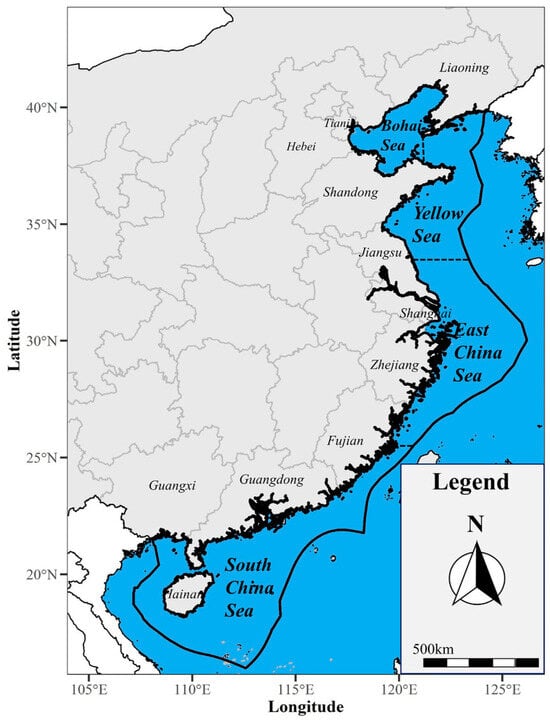
Figure 1
Open AccessArticle
Molecular Mechanisms of Low-Temperature Stress Response in the Muscle of Yellowtail Kingfish (Seriola aureovittata)
by
Yushun Tian, Ruonan Zhang, Bingxin Wu, Mingxin Ji, Xinyang Li, Xinyu Cao and Chen Jiang
Fishes 2025, 10(7), 355; https://doi.org/10.3390/fishes10070355 - 18 Jul 2025
Abstract
The yellowtail kingfish (Seriola aureovittata), a commercially important marine species, encounters significant survival challenges under low-temperature conditions during winter aquaculture. To elucidate its molecular adaptation mechanisms, this study employed RNA-Seq to analyze transcriptional responses in juvenile muscle tissues under acute cold
[...] Read more.
The yellowtail kingfish (Seriola aureovittata), a commercially important marine species, encounters significant survival challenges under low-temperature conditions during winter aquaculture. To elucidate its molecular adaptation mechanisms, this study employed RNA-Seq to analyze transcriptional responses in juvenile muscle tissues under acute cold stress (10 °C) at 0, 6, 12, and 24 h. Differential gene expression analysis revealed time-dependent patterns, with 269, 863, and 984 differentially expressed genes (DEGs) identified at 6, 12, and 24 h, respectively. Key pathways were identified, including lipid metabolism, carbohydrate metabolism, and stress response. Sestrin3 upregulation implicated AMPK-mediated energy homeostasis in cold adaptation. These findings provide novel insights into the molecular strategies underlying cold adaptation in yellowtail kingfish, offering potential targets for breeding cold-resistant strains and improving aquaculture resilience.
Full article
(This article belongs to the Special Issue Environmental Physiology of Aquatic Animals)
►▼
Show Figures

Figure 1
Open AccessArticle
The Biogeographic Patterns of Two Typical Mesopelagic Fishes in the Cosmonaut Sea Through a Combination of Environmental DNA and a Trawl Survey
by
Yehui Wang, Chunlin Liu, Mi Duan, Peilong Ju, Wenchao Zhang, Shuyang Ma, Jianchao Li, Jianfeng He, Wei Shi and Yongjun Tian
Fishes 2025, 10(7), 354; https://doi.org/10.3390/fishes10070354 - 17 Jul 2025
Abstract
Investigating biodiversity in remote and harsh environments, particularly in the Southern Ocean, remains costly and challenging through traditional sampling methods such as trawling. Environmental DNA (eDNA) sampling, which refers to sampling genetic material shed by organisms from environmental samples (e.g., water), provides a
[...] Read more.
Investigating biodiversity in remote and harsh environments, particularly in the Southern Ocean, remains costly and challenging through traditional sampling methods such as trawling. Environmental DNA (eDNA) sampling, which refers to sampling genetic material shed by organisms from environmental samples (e.g., water), provides a more cost-effective and sustainable alternative to traditional sampling approaches. To study the biogeographic patterns of two typical mesopelagic fishes, Antarctic lanternfish (Electrona antarctica) and Antarctic deep-sea smelt (Bathylagus antarcticus), in the Cosmonaut Sea in the Indian Ocean sector of the Southern Ocean, we conducted both eDNA and trawling sampling at a total of 86 stations in the Cosmonaut Sea during two cruises in 2021–2022. Two sets of species-specific primers and probes were developed for a quantitative eDNA analysis of two fish species. Both the eDNA and trawl results indicated that the two fish species are widely distributed in the Cosmonaut Sea, with no significant difference in eDNA concentration, biomass, or abundance between stations. Spatially, E. antarctica tended to be distributed in shallow waters, while B. antarcticus tended to be distributed in deep waters. Vertically, E. antarctica was more abundant above 500 m, while B. antarcticus had a wider range of habitat depths. The distribution patterns of both species were affected by nutrients, with E. antarctica additionally affected by chlorophyll, indicating that their distribution is primarily influenced by food resources. Our study provides broader insight into the biogeographic patterns of the two mesopelagic fishes in the remote Cosmonaut Sea, demonstrates the potential of combining eDNA with traditional methods to study biodiversity and ecosystem dynamics in the Southern Ocean and even at high latitudes, and contributes to future ecosystem research and biodiversity conservation in the region.
Full article
(This article belongs to the Section Biology and Ecology)
►▼
Show Figures
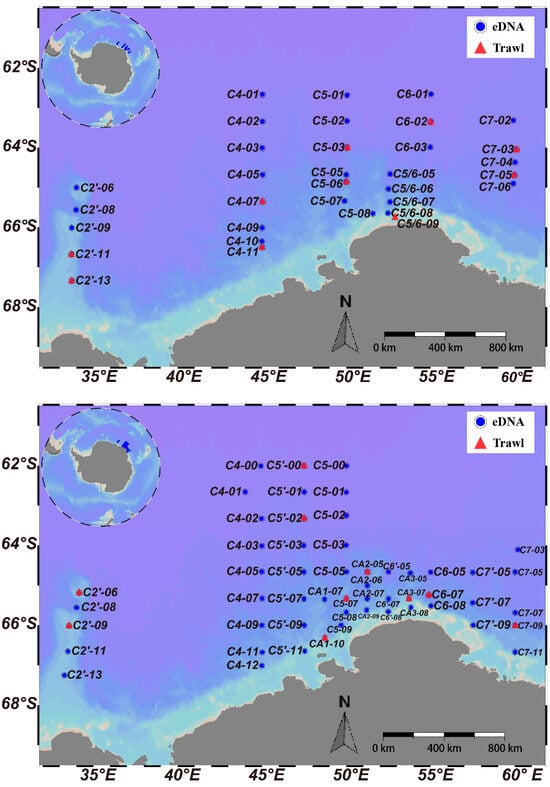
Figure 1
Open AccessReview
Multifunctional Applications of Biofloc Technology (BFT) in Sustainable Aquaculture: A Review
by
Changwei Li and Limin Dai
Fishes 2025, 10(7), 353; https://doi.org/10.3390/fishes10070353 - 17 Jul 2025
Abstract
Biofloc technology (BFT), traditionally centered on feed supplementation and water purification in aquaculture, harbors untapped multifunctional potential as a sustainable resource management platform. This review systematically explores beyond conventional applications. BFT leverages microbial consortia to drive resource recovery, yielding bioactive compounds with antibacterial/antioxidant
[...] Read more.
Biofloc technology (BFT), traditionally centered on feed supplementation and water purification in aquaculture, harbors untapped multifunctional potential as a sustainable resource management platform. This review systematically explores beyond conventional applications. BFT leverages microbial consortia to drive resource recovery, yielding bioactive compounds with antibacterial/antioxidant properties, microbial proteins for efficient feed production, and algae biomass for nutrient recycling and bioenergy. In environmental remediation, its porous microbial aggregates remove microplastics and heavy metals through integrated physical, chemical, and biological mechanisms, addressing critical aquatic pollution challenges. Agri-aquatic integration systems create symbiotic loops where nutrient-rich aquaculture effluents fertilize plant cultures, while plants act as natural filters to stabilize water quality, reducing freshwater dependence and enhancing resource efficiency. Emerging applications, including pigment extraction for ornamental fish and the anaerobic fermentation of biofloc waste into organic amendments, further demonstrate its alignment with circular economy principles. While technical advancements highlight its capacity to balance productivity and ecological stewardship, challenges in large-scale optimization, long-term system stability, and economic viability necessitate interdisciplinary research. By shifting focus to its underexplored functionalities, this review positions BFT as a transformative technology capable of addressing interconnected global challenges in food security, pollution mitigation, and sustainable resource use, offering a scalable framework for the future of aquaculture and beyond.
Full article
(This article belongs to the Section Sustainable Aquaculture)
►▼
Show Figures
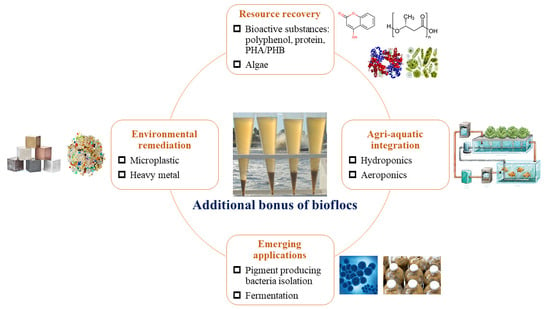
Graphical abstract
Open AccessArticle
Morphological and Metabolic Adaptations to Increasing Temperature: Insights from the In Vitro Model of Maraena Whitefish
by
Katrin Tönißen, Julia Brenmoehl, Heike Wanka and Bianka Grunow
Fishes 2025, 10(7), 352; https://doi.org/10.3390/fishes10070352 - 16 Jul 2025
Abstract
Physiological changes in animals induced by environmental shifts in aquatic ecosystems can be studied using fish cell lines derived from vulnerable species. Therefore, we investigated how environmental shifts—specifically, an increase of 5 °C in temperature—impact the physiology of the cell line CMAfin1 derived
[...] Read more.
Physiological changes in animals induced by environmental shifts in aquatic ecosystems can be studied using fish cell lines derived from vulnerable species. Therefore, we investigated how environmental shifts—specifically, an increase of 5 °C in temperature—impact the physiology of the cell line CMAfin1 derived from maraena whitefish (Coregonus maraena). Cellular growth, morphology, and metabolic responses were examined under two growth conditions: a control temperature of 20 °C and an elevated temperature of 25 °C. Using trypan blue staining, automated cell counting, phase contrast microscopy, and actin staining, we observed morphological changes in the cells. Metabolic functions were assessed using a Seahorse XFe96 Flux Analyzer, focusing on the bioenergetic capacities of mitochondrial respiration and glycolytic activity. Hyperthermia resulted in faster growth rates but reduced cell size in the CMAfin1 cell line. The cells’ metabolic activity (mitochondrial respiration and glycolytic activity) was inhibited, leading to a quiescent energy state. Our findings indicate reduced motility and altered intercellular communication at higher temperatures. The results highlight the potential of in vitro models to study environmental stress on fish physiology and emphasize the value of fish cell lines for understanding metabolic responses.
Full article
(This article belongs to the Section Physiology and Biochemistry)
►▼
Show Figures
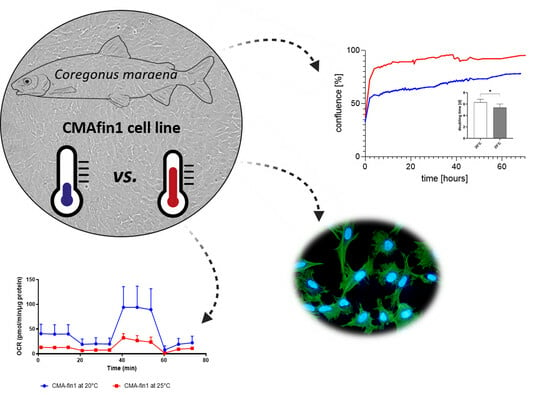
Graphical abstract
Open AccessCommunication
First Record of Lyconus brachycolus (Gadiformes: Lyconidae) in Spanish Waters: An Update on Taxonomic Knowledge
by
Rafael Bañón, Alejandro de Carlos and Juan Carlos Arronte
Fishes 2025, 10(7), 351; https://doi.org/10.3390/fishes10070351 - 15 Jul 2025
Abstract
This study reports the first record of Lyconus brachycolus in Spanish waters. A single specimen measuring 216 mm in total length was captured on 13 October 2024 in the Cantabrian Sea (north of Spain, 43.8467 N, −6.2109 W) by bottom trawl at a
[...] Read more.
This study reports the first record of Lyconus brachycolus in Spanish waters. A single specimen measuring 216 mm in total length was captured on 13 October 2024 in the Cantabrian Sea (north of Spain, 43.8467 N, −6.2109 W) by bottom trawl at a depth of 412 m. A detailed morphological description, updated characteristics, and illustrations are provided. For comparative purposes, an update of the species’ morphological characteristics was carried out. In an integrative taxonomic approach, the DNA barcode was obtained, which confirmed the morphological identification of the specimen as Lyconus brachycolus. A molecular taxonomic analysis using this marker showed the existence of two clades separated by 5.1%, corresponding to Lyconus brachycolus and Lyconus pinnatus, the two currently valid species of the genus.
Full article
(This article belongs to the Section Taxonomy, Evolution, and Biogeography)
►▼
Show Figures

Figure 1
Open AccessArticle
Asparagopsis taxiformis Feed Supplementation as a Tool to Improve the Resilience of Farmed Diplodus sargus to Marine Heatwave Events—A Metabolomics Approach
by
Marta Dias, Isa Marmelo, Carla António, Ana M. Rodrigues, António Marques, Mário S. Diniz and Ana Luísa Maulvault
Fishes 2025, 10(7), 350; https://doi.org/10.3390/fishes10070350 - 15 Jul 2025
Abstract
The need to maximize aquaculture production while addressing environmental and food security challenges posed by climate change has driven research towards the development of functional aquafeeds that enhance performance and immunity in farmed species. However, exposure to dietary and environmental stressors affects marine
[...] Read more.
The need to maximize aquaculture production while addressing environmental and food security challenges posed by climate change has driven research towards the development of functional aquafeeds that enhance performance and immunity in farmed species. However, exposure to dietary and environmental stressors affects marine organisms, altering key metabolic pathways best understood through high-throughput “omics” tools. This study assessed the effects of Asparagopsis taxiformis supplementation on central metabolic pathways by analyzing changes in primary metabolite levels in the liver of farmed Diplodus sargus under optimal and suboptimal temperature conditions. Results showed that seaweed supplementation had a beneficial effect on the fish’s primary metabolome; however, inclusion levels and rearing conditions played a crucial role in determining outcomes. While 1.5% supplementation maintained a balanced primary metabolome under optimal temperature conditions, 3.0% supplementation most effectively mitigated the adverse effects of acute thermal stress during a marine heatwave. These findings highlight the nutritive and functional potential of A. taxiformis supplementation in aquafeeds for marine omnivorous fish species and emphasize the importance of evaluating functional aquafeeds under suboptimal rearing conditions. Overall, our results demonstrate the value of metabolomics in elucidating the molecular basis underlying biological pathways in farmed marine fish and optimizing production through climate-smart dietary strategies.
Full article
(This article belongs to the Special Issue Advances in Aquaculture Feed Additives)
►▼
Show Figures
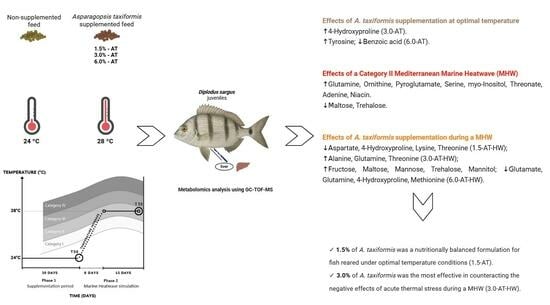
Graphical abstract
Open AccessArticle
The Investigation of the Effect of Feeds with Probiotic Additives on Growth and Functional State of Juvenile Steelhead Salmo (Salmo gairdneri)
by
Elena N. Ponomareva, Marina N. Sorokina, Vadim A. Grigoriev, Mariya S. Mazanko, Vladimir A. Chistyakov and Dmitry V. Rudoy
Fishes 2025, 10(7), 349; https://doi.org/10.3390/fishes10070349 - 14 Jul 2025
Abstract
The research on the effect of feed with probiotic additives on the growth and functional state of young steelhead salmon (Salmo gairdneri) is presented in this study. For the first time, target strains selected not only by antagonism to pathogens but
[...] Read more.
The research on the effect of feed with probiotic additives on the growth and functional state of young steelhead salmon (Salmo gairdneri) is presented in this study. For the first time, target strains selected not only by antagonism to pathogens but also by their ability to produce lytic enzymes or secondary metabolites with antioxidant activity were used to create probiotic preparations for aquaculture. This study presents findings showing that groups of fish fed probiotic feeds showed an improved growth performance and higher survival rate compared to the control. It was noted that the weights of fish in the first variant and the second variant of the experiment were higher by 8.8% and 6.8%, respectively. This research showed that juvenile steelhead salmon reared with probiotic-supplemented feeds had an improved ability to survive in high salinity and sublethal temperatures. This indicates that probiotics may play a significant role in enhancing the adaptive system of fish.
Full article
(This article belongs to the Section Nutrition and Feeding)
►▼
Show Figures

Figure 1
Open AccessArticle
Mobile-YOLO: A Lightweight Object Detection Algorithm for Four Categories of Aquatic Organisms
by
Hanyu Jiang, Jing Zhao, Fuyu Ma, Yan Yang and Ruiwen Yi
Fishes 2025, 10(7), 348; https://doi.org/10.3390/fishes10070348 - 14 Jul 2025
Abstract
Accurate and rapid aquatic organism recognition is a core technology for fisheries automation and aquatic organism statistical research. However, due to absorption and scattering effects, images of aquatic organisms often suffer from poor contrast and color distortion. Additionally, the clustering behavior of aquatic
[...] Read more.
Accurate and rapid aquatic organism recognition is a core technology for fisheries automation and aquatic organism statistical research. However, due to absorption and scattering effects, images of aquatic organisms often suffer from poor contrast and color distortion. Additionally, the clustering behavior of aquatic organisms often leads to occlusion, further complicating the identification task. This study proposes a lightweight object detection model, Mobile-YOLO, for the recognition of four representative aquatic organisms, namely holothurian, echinus, scallop, and starfish. Our model first utilizes the Mobile-Nano backbone network we proposed, which enhances feature perception while maintaining a lightweight design. Then, we propose a lightweight detection head, LDtect, which achieves a balance between lightweight structure and high accuracy. Additionally, we introduce Dysample (dynamic sampling) and HWD (Haar wavelet downsampling) modules, aiming to optimize the feature fusion structure and achieve lightweight goals by improving the processes of upsampling and downsampling. These modules also help compensate for the accuracy loss caused by the lightweight design of LDtect. Compared to the baseline model, our model reduces Params (parameters) by 32.2%, FLOPs (floating point operations) by 28.4%, and weights (model storage size) by 30.8%, while improving FPS (frames per second) by 95.2%. The improvement in mAP (mean average precision) can also lead to better accuracy in practical applications, such as marine species monitoring, conservation efforts, and biodiversity assessment. Furthermore, the model’s accuracy is enhanced, with the mAP increased by 1.6%, demonstrating the advanced nature of our approach. Compared with YOLO (You Only Look Once) series (YOLOv5-12), SSD (Single Shot MultiBox Detector), EfficientDet (Efficient Detection), RetinaNet, and RT-DETR (Real-Time Detection Transformer), our model achieves leading comprehensive performance in terms of both accuracy and lightweight design. The results indicate that our research provides technological support for precise and rapid aquatic organism recognition.
Full article
(This article belongs to the Special Issue Technology for Fish and Fishery Monitoring)
►▼
Show Figures

Figure 1
Open AccessArticle
Preliminary Study on Some Blood Parameters of White Snook (Centropomus viridis) Broodstock Reared in Aquaculture Recirculating System (RAS)
by
Iris Adriana Hernández-López, Virginia Patricia Domínguez-Jiménez, Rosa María Medina-Guerrero, Rodolfo Lozano-Olvera, Oscar Basilio Del Rio-Zaragoza, Leonardo Ibarra-Castro, Juan Manuel Martínez-Brown and Emyr Saúl Peña-Marín
Fishes 2025, 10(7), 347; https://doi.org/10.3390/fishes10070347 - 14 Jul 2025
Abstract
►▼
Show Figures
The white snook (Centropomus viridis) is an emerging aquaculture species with high market acceptance, exhibiting catadromous and protandric hermaphroditic characteristics in adulthood. This study aimed to preliminarily characterize certain hematological and biochemical parameters, as well as blood cell morphology, for identifying
[...] Read more.
The white snook (Centropomus viridis) is an emerging aquaculture species with high market acceptance, exhibiting catadromous and protandric hermaphroditic characteristics in adulthood. This study aimed to preliminarily characterize certain hematological and biochemical parameters, as well as blood cell morphology, for identifying possible variations between sexes maintained under aquaculture recirculating system (RAS) conditions. The white snook broodstock was anesthetized with clove oil, and biometric values, as well as sex classification, were measured. Then, blood samples were collected from 14 females (7132 ± 1610 g) and 20 males (2200 ± 0.963 g) via caudal vessel puncture to analyze selected hematological parameters, blood biochemistry, and cellular morphology. Fulton’s condition factor (K) showed no differences between sexes, indicating a healthy fish status. Females showed significantly higher serum cholesterol, glucose, and triglyceride levels than males. Also, hematocrit (HCT) and mean corpuscular volume (MCV) were elevated in females. No sex-related differences were observed in red or white cell counts or in blood cell dimensions. Morphological characterization identified erythrocytes, thrombocytes, and three types of leukocytes: lymphocytes (small and large lymphocytes), neutrophils, and monocytes, with no eosinophils or basophils detected in either sex. These findings provide fundamental reference values for the hematological and biochemical profiles of C. viridis broodstock in captivity and highlight sex-specific differences relevant for reproductive and health monitoring. However, it should be considered that the sample size used to establish reference ranges for the species is small, so it is recommended to implement a monitoring plan for this and other broodstocks of this emerging species.
Full article
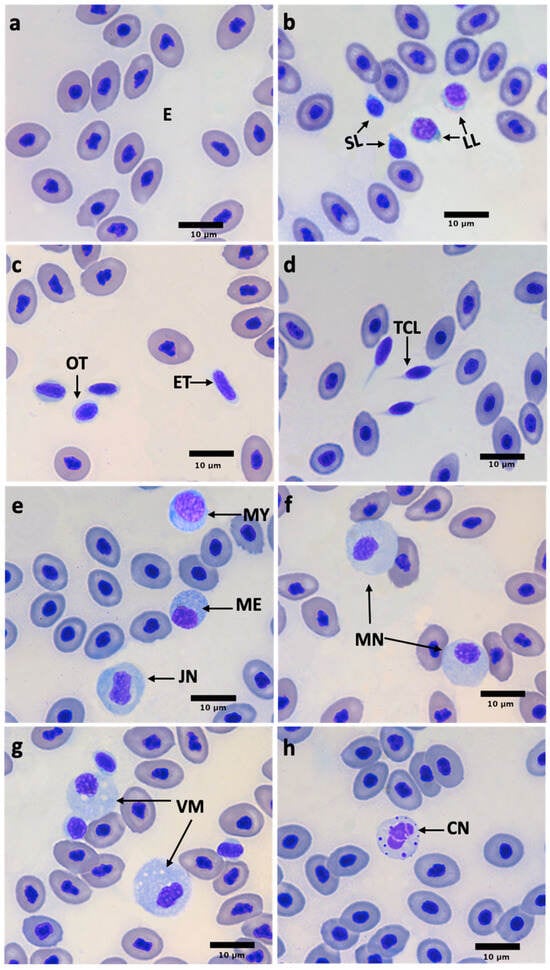
Figure 1
Open AccessArticle
Effect of Flaxseed Gum on the Gelling and Structural Properties of Fish Gelatin
by
Ting-Ting Wu, Ya-Ting Kuang, Chun-Yan Peng, Xin-Wu Hu, Ping Yuan, Xiao-Mei Sha and Zi-Zi Hu
Fishes 2025, 10(7), 346; https://doi.org/10.3390/fishes10070346 - 14 Jul 2025
Abstract
Fish gelatin (FG) has garnered significant attention as an alternative to mammalian gelatin, primarily attributed to its distinct advantages. These include the absence of epidemic transmission risks and the lack of religious restrictions, making it a more universally acceptable and safer option. However,
[...] Read more.
Fish gelatin (FG) has garnered significant attention as an alternative to mammalian gelatin, primarily attributed to its distinct advantages. These include the absence of epidemic transmission risks and the lack of religious restrictions, making it a more universally acceptable and safer option. However, its application is limited due to shortcomings such as insufficient gel properties (such as rheological properties, gel strength, etc.). In this study, flaxseed gum (FFG) of 0–1.2% w/v was used to modify FG. The rheological properties, structural characteristics, and chemical bond changes of FG before and after modification were systematically analyzed using instruments such as a rheometer, infrared spectrometer, and Zeta potential analyzer. The results revealed that an appropriate amount of FFG could increase the gel strength of FG, but excessive FFG (>0.4%) reduced its gel strength. Moreover, FFG could increase the gelation transition temperature and apparent viscosity of the composite gel. FTIR confirmed that FFG and FG were bound through hydrogen bonding, β-sheet structure formation, and multi-electrolyte complexation. The ESEM showed that FFG promoted the formation of a denser network structure of FG. This study laid a theoretical foundation for the application and development of FG in the field of high-gel foods.
Full article
(This article belongs to the Special Issue Fish Processing and Preservation Technologies)
►▼
Show Figures
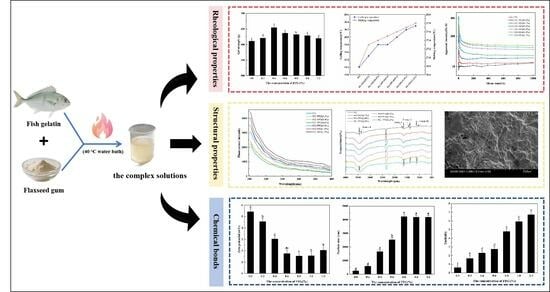
Graphical abstract
Open AccessArticle
Evaluation of Seaweed Meal and Konjac Glucomannan Mixture as Feed Ingredients in Largemouth Bass Micropterus salmoides
by
Yan-Bo Cheng, Dan Wu, Liang Gao, Shun Rong, Guo-Huan Xu and Xu-Fang Liang
Fishes 2025, 10(7), 345; https://doi.org/10.3390/fishes10070345 - 11 Jul 2025
Abstract
To address the negative effects of high-starch diets on largemouth bass (LMB), this study evaluated the feasibility of using a Gracilaria lemaneiformis-konjac glucomannan mixture (GKM, 2:1) as a substitute for strong flour (SF). Four iso-nitrogenous and iso-lipid diets were formulated: a control
[...] Read more.
To address the negative effects of high-starch diets on largemouth bass (LMB), this study evaluated the feasibility of using a Gracilaria lemaneiformis-konjac glucomannan mixture (GKM, 2:1) as a substitute for strong flour (SF). Four iso-nitrogenous and iso-lipid diets were formulated: a control (15% SF; GK00) and three other diets replacing 33.3% (GK05), 66.7% (GK10), or 100% (GK15) of SF with GKM. Each diet was randomly administered to triplicate tanks of fish (10.49 ± 0.232 g) for a 10-week feeding trial. Results showed that the GKM inclusion groups significantly improved the fish survival and feed intake. Fish in GK05 and GK10 groups exhibited significantly higher final body weight, weight gain, and specific growth rate than the GK00 group, while GK15 showed no significant increase in these metrics. There was no impairment in protein, lipid, phosphorus, and energy retention efficiency in the GK05 and GK10 groups compared to those of the GK00 group. Apparent digestibility for feed dry matter, protein, lipid, phosphorus, and the 16 amino acids was not decreased in the GK05 and GK10 groups relative to the GK00 group. In addition, this study revealed reduced phosphorus waste per kilogram of weight gain in GK05 and GK10. In conclusion, these findings position GKM as a sustainable alternative to SF in feed for LMB.
Full article
(This article belongs to the Special Issue Development of Low-Crop, Low-Fishmeal or Low-Fish Oil Feeds for Aquaculture)
►▼
Show Figures

Figure 1
Open AccessArticle
Black Soldier Fly Larvae Meal as a Sustainable Fishmeal Substitute for Juvenile Hybrid Grouper: Impacts on Growth, Immunity, and Gut Health
by
Yan Chen, Wenfeng Li, Minyi Zhong, Jun Ma, Bing Chen, Junming Cao, Jiun-Yan Loh and Hai Huang
Fishes 2025, 10(7), 344; https://doi.org/10.3390/fishes10070344 - 11 Jul 2025
Abstract
Background: Aquaculture increasingly seeks sustainable alternatives to fishmeal, a key protein source in fish diets. Black Soldier Fly Larvae (BSFL) meal is a promising substitute, but its effects on fish growth, immunity, and gut health need further investigation. This study aimed to evaluate
[...] Read more.
Background: Aquaculture increasingly seeks sustainable alternatives to fishmeal, a key protein source in fish diets. Black Soldier Fly Larvae (BSFL) meal is a promising substitute, but its effects on fish growth, immunity, and gut health need further investigation. This study aimed to evaluate the impact of varying BSFL inclusion levels on juvenile hybrid grouper (Epinephelus fuscoguttatus ♀ × Epinephelus lanceolatus ♂), a widely farmed species in tropical aquaculture. Methods: Juvenile hybrid grouper were fed diets with four levels of BSFL substitution (0%, 10%, 30%, and 50%) over 56 days. Key metrics such as growth performance, immune function, antioxidant capacity, and gut transcriptome were analyzed. Results: Replacing fish meal with BSFL meal had no significant effect on the survival rate of hybrid grouper (p > 0.05) but significantly affected growth performance, immune function, and antioxidant capacity (p < 0.05). BSFL10 and BSFL30 groups showed good growth and elevated immune enzyme activity, with significantly higher HIS levels (p < 0.05); the Wf of the BSFL10 group was comparable to the control. However, excessive replacement (BSFL50) led to reduced growth (Wf significantly lower, p < 0.05) and increased oxidative stress, as indicated by higher CAT activity (p < 0.05). Transcriptomic analysis revealed upregulation of immune- and metabolism-related genes with increasing BSFL levels, with immune pathways notably activated in the BSFL50 group. Conclusions: BSFL meal is a promising alternative to fishmeal in juvenile hybrid grouper diets, with moderate inclusion (10–30%) being most beneficial. Excessive BSFL substitution (50%) may impair fish health, highlighting the need for careful formulation in aquaculture diets.
Full article
(This article belongs to the Section Nutrition and Feeding)
►▼
Show Figures

Figure 1
Open AccessArticle
Spatial–Seasonal Shifts in Phytoplankton and Zooplankton Community Structure Within a Subtropical Plateau Lake: Interplay with Environmental Drivers During Rainy and Dry Seasons
by
Chengjie Yin, Li Gong, Jiaojiao Yang, Yalan Yang and Longgen Guo
Fishes 2025, 10(7), 343; https://doi.org/10.3390/fishes10070343 - 11 Jul 2025
Abstract
Subtropical plateau lakes, which are distinguished by their elevated altitudes and subtropical climates, display distinct ecological dynamics. Nevertheless, the spatial and seasonal variations in the plankton community structure, as well as their interactions with environmental factors, remain inadequately understood. This study investigated the
[...] Read more.
Subtropical plateau lakes, which are distinguished by their elevated altitudes and subtropical climates, display distinct ecological dynamics. Nevertheless, the spatial and seasonal variations in the plankton community structure, as well as their interactions with environmental factors, remain inadequately understood. This study investigated the alterations in the phytoplankton and zooplankton community structure across different geographical regions (southern, central, and northern) and seasonal periods (rainy and dry) in Erhai lake, located in a subtropical plateau in China. The results indicated that the average values of total nitrogen (TN), total phosphorus (TP), chlorophyll-a (Chla), pH, and conductivity are significantly higher during the rainy season in comparison to the dry season. Furthermore, during the rainy season, there were significant differences in the concentrations of TN, TP, and Chla among the three designated water areas. Notable differences were also observed in the distribution of Microcystis, the density of Cladocera and copepods, and the biomass of copepods across the three regions during this season. Conversely, in the dry season, only the biomass of Cladocera exhibited significant variation among the three water areas. The redundancy analysis (RDA) and variance partitioning analysis demonstrated that the distribution of plankton groups (Cyanophyta, Cryptophyta, and Cladocera) is significantly associated with TN, Secchi depth (SD), and Chla during the rainy season, whereas it is significantly correlated with TP and SD during the dry season. These findings underscore the critical influence of environmental factors, shaped by rainfall patterns, in driving these ecological changes. In the context of the early stages of eutrophication in Lake Erhai, it is essential to ascertain the spatial distribution of water quality parameters, as well as phytoplankton and zooplankton density and biomass, during both the rainy and dry seasons.
Full article
(This article belongs to the Section Biology and Ecology)
►▼
Show Figures
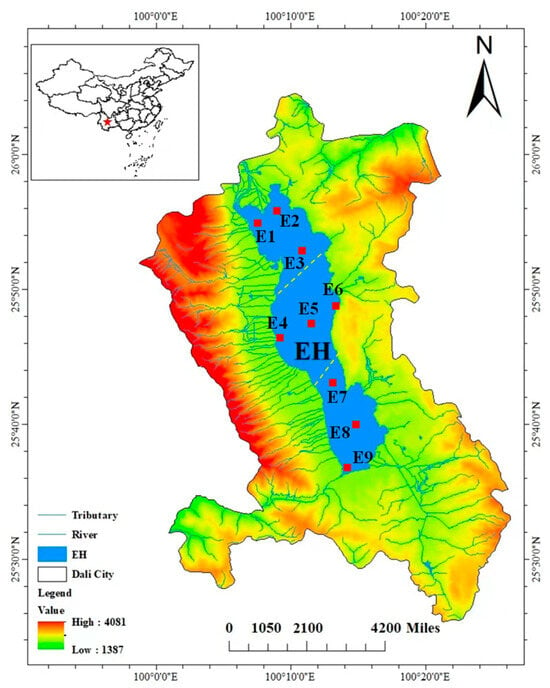
Figure 1
Open AccessArticle
Limit Reference Points and Equilibrium Stock Dynamics in the Presence of Recruitment Depensation
by
Timothy J. Barrett and Quang C. Huynh
Fishes 2025, 10(7), 342; https://doi.org/10.3390/fishes10070342 - 11 Jul 2025
Abstract
Depensation (or an Allee effect) has recently been detected in stock–recruitment relationships (SRRs) in four Atlantic herring stocks and one Atlantic cod stock using a Bayesian statistical approach. In the present study, we define the Allee effect threshold (BAET) for
[...] Read more.
Depensation (or an Allee effect) has recently been detected in stock–recruitment relationships (SRRs) in four Atlantic herring stocks and one Atlantic cod stock using a Bayesian statistical approach. In the present study, we define the Allee effect threshold (BAET) for these five stocks and propose BAET as a candidate limit reference point (LRP). We compare BAET to traditional LRPs based on proportions of equilibrium unfished biomass (B0) and biomass at maximum sustainable yield (BMSY) assuming a Beverton–Holt or Ricker SRR with and without depensation, and to the change point from a hockey stick SRR (BCP). The BAET for the case studies exceeded 0.2 B0 and 0.4 BMSY for three of the case study stocks and exceedances of 0.2 B0 were more common when the Ricker form of the SRR was assumed. The BAET estimates for all case studies were less than BCP. When there is depensation in the SRR, multiple equilibrium states can exist when fishing at a fixed fishing mortality rate (F) because the equilibrium recruits-per-spawner line at a given F can intersect the SRR more than once. The equilibrium biomass is determined by whether there is excess recruitment at the initial projected stock biomass. Estimates of equilibrium FMSY in the case studies were generally higher for SRRs that included the depensation parameter; however, the long-term F that would lead the stock to crash (Fcrash) in the depensation SRRs was often about half the Fcrash for SRRs without depensation. When warranted, this study recommends exploration of candidate LRPs from depensatory SRRs, especially if Allee effect thresholds exceed commonly used limits, and simulation testing of management strategies for robustness to depensatory effects.
Full article
(This article belongs to the Special Issue Fisheries Monitoring and Management)
►▼
Show Figures

Figure 1
Open AccessArticle
Integrated Transcriptome and Microbiome Analyses Reveal Growth- and Stress-Response-Related Genes and Microbes in Mandarin Fish (Siniperca chuatsi)
by
Fan Zhou, Wei Liu, Ming Qi, Qianrong Liang, Gaohua Yao, Cheng Ma, Xueyan Ding, Zaihang Yu, Xinyu Li and Zhanqi Wang
Fishes 2025, 10(7), 341; https://doi.org/10.3390/fishes10070341 - 10 Jul 2025
Abstract
Mandarin fish (Siniperca chuatsi) are known to exhibit distinct physiological and immunological adaptations to environmental stressors, but the underlying molecular and microbial mechanisms remain unclear. In this study, we integrated transcriptome and microbiome analyses to investigate adaptations across three geographically distinct
[...] Read more.
Mandarin fish (Siniperca chuatsi) are known to exhibit distinct physiological and immunological adaptations to environmental stressors, but the underlying molecular and microbial mechanisms remain unclear. In this study, we integrated transcriptome and microbiome analyses to investigate adaptations across three geographically distinct mandarin fish groups: Guangdong (G), Qiupu (Q), and native Taihu (T). Liver RNA sequencing revealed 5339 differentially expressed genes (DEGs) between T and G and 1531 DEGs between T and Q. Functional enrichment analysis revealed group-specific responses. Specifically, DEGs from T vs. G were linked to small-molecule metabolism and innate immunity whereas the DEGs from T vs. Q were related to immune regulation and chromatin organization. The concurrent 16S rRNA sequencing of the intestinal microbiota identified 2680 amplicon sequence variants, with principal coordinate analysis showing distinct clustering (31.77% variance). Group T had higher Firmicutes abundance whereas groups G and Q had a higher relative abundance of Fusobacteriota. Correlation networks revealed key microbe–gene interactions, including positive links between Lactobacillus and immune genes in group T and negative associations with Romboutsia. These findings suggest that enhanced immune homeostasis and metabolic flexibility in group T may result from coordinated host gene expression and Lactobacillus-driven microbiome modulation. We provide new insights into the mechanisms of adaptation in mandarin fish and identify potential biomarkers for enhancing aquaculture resilience.
Full article
(This article belongs to the Special Issue Fish Nutrition and Immunology)
►▼
Show Figures
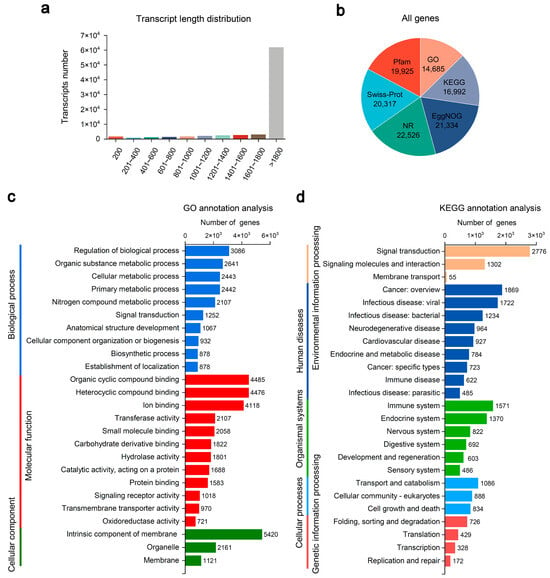
Figure 1
Open AccessArticle
Eat First, Fight Later: Competitive Advantage of an Invasive Cichlid over a Native Competitor for Food Resources
by
Leonardo Cirillo, Caio A. Miyai, Fábio H. C. Sanches, Alexandre L. Arvigo and Tânia M. Costa
Fishes 2025, 10(7), 340; https://doi.org/10.3390/fishes10070340 - 10 Jul 2025
Abstract
Competition for resources with invasive species can negatively impact native fauna. Invasive species often exhibit higher aggressiveness and monopolize resources through behavioral interference. However, their feeding behavior also plays a central role in invasion success. We investigated how food resource availability influences agonistic
[...] Read more.
Competition for resources with invasive species can negatively impact native fauna. Invasive species often exhibit higher aggressiveness and monopolize resources through behavioral interference. However, their feeding behavior also plays a central role in invasion success. We investigated how food resource availability influences agonistic interactions between the invasive cichlid Oreochromis niloticus and the native cichlid Geophagus iporangensis. Specifically, we assessed whether the invasive species interferes with the native species’ feeding behavior. Using neutral arenas, we staged competition trials under two conditions: initially without food and subsequently with food present. The native species served as the focal animal and was exposed to either a conspecific or an invasive competitor. Results showed that native species aggressiveness toward the invasive competitor was three times higher in the absence of food. Although O. niloticus was 1.6 times more aggressive than conspecifics, its presence did not affect the native species’ feeding rate, and no behavioral interference was observed. Instead, the invasive species relied primarily on scramble competition, initiating nine of ten trials and consuming seven times more food than the native cichlid. Our findings suggest that, beyond aggression, feeding behavior and resource exploitation are key mechanisms driving competitive exclusion by invasive species.
Full article
(This article belongs to the Special Issue Behavioral Ecology of Fishes)
►▼
Show Figures

Figure 1
Open AccessReview
Molecular Mechanisms and Biomarker-Based Early-Warning Indicators of Heavy Metal Toxicity in Marine Fish
by
Andra Oros, Valentina Coatu, Nicoleta Damir, Diana Danilov, Elena Ristea and Luminita Lazar
Fishes 2025, 10(7), 339; https://doi.org/10.3390/fishes10070339 - 10 Jul 2025
Abstract
Heavy metals are among the most persistent and bioaccumulative pollutants in marine ecosystems, posing significant toxicological threats to fish via complex molecular and cellular disruptions. This review synthesizes current knowledge on the cascade of mechanistic responses in marine fish following HM exposure, which
[...] Read more.
Heavy metals are among the most persistent and bioaccumulative pollutants in marine ecosystems, posing significant toxicological threats to fish via complex molecular and cellular disruptions. This review synthesizes current knowledge on the cascade of mechanistic responses in marine fish following HM exposure, which includes oxidative stress, modulation of antioxidant responses, activation of detoxification systems, DNA damage, inflammation, apoptosis, neuroendocrine disruption, and ultimately, cellular energy imbalance. In addition to established pathways, the review highlights recent advances in mechanistic understanding and biomarker development, including cellular stress responses, epigenetic regulation, metal homeostasis mechanisms, and novel molecular indicators. These mechanisms support the development of an integrated biomarker framework that combines classical indicators (e.g., antioxidant enzymes, metallothionein) with next-generation endpoints (e.g., miRNA profiles, gene-level responses of metal transporters or stress chaperones, epigenetic alterations). The interpretation of biomarker responses requires consideration of the exposure context, environmental variables, and physiological status to ensure accurate assessment of sublethal toxicity in field settings. By bridging mechanistic understanding with biomonitoring relevance, this review provides a comprehensive foundation for advancing molecular tools in pollution monitoring and risk assessment. Special emphasis is placed on biomarkers specific to heavy metal exposure, enhancing their diagnostic value relative to general stress indicators.
Full article
(This article belongs to the Section Environment and Climate Change)
►▼
Show Figures

Graphical abstract
Open AccessArticle
Remote Sensing Reveals Multi-Dimensional Functional Changes in Fish Assemblages Under Eutrophication and Hydrological Stress
by
Anastasiia Zymaroieva, Dmytro Bondarev, Olga Kunakh, Jens-Christian Svenning and Oleksander Zhukov
Fishes 2025, 10(7), 338; https://doi.org/10.3390/fishes10070338 - 9 Jul 2025
Abstract
►▼
Show Figures
Understanding how fish communities respond to long-term environmental changes in regulated floodplain ecosystems is essential for managing biodiversity amid increasing anthropogenic and climatic pressures. This study evaluates the spatiotemporal dynamics of functional diversity in juvenile fish assemblages within the Dnipro-Orilskiy Nature Reserve (Ukraine)
[...] Read more.
Understanding how fish communities respond to long-term environmental changes in regulated floodplain ecosystems is essential for managing biodiversity amid increasing anthropogenic and climatic pressures. This study evaluates the spatiotemporal dynamics of functional diversity in juvenile fish assemblages within the Dnipro-Orilskiy Nature Reserve (Ukraine) from 1997 to 2015. By employing a combination of extensive ichthyological field surveys and satellite-derived environmental indices (including NDVI, chlorophyll-a, turbidity, and spectral proxies for algal blooms), we assessed the impacts of eutrophication, hydrological alterations, and climate warming on functional structure. Our results reveal three key responses in fish functional diversity: (1) a decline in functional specialization and imbalance, indicating the loss of unique ecological roles and increased redundancy; (2) a rise in functional divergence, reflecting a shift toward species with outlying trait combinations; and (3) a complex pattern in functional richness, with trends varying by site and trait structure. These shifts are linked to increasing eutrophication and warming, particularly in floodplain areas. Remote sensing effectively captured spatial variation in eutrophication-related water quality and proved to be a powerful tool for linking environmental change to fish community dynamics, not least in inaccessible areas.
Full article
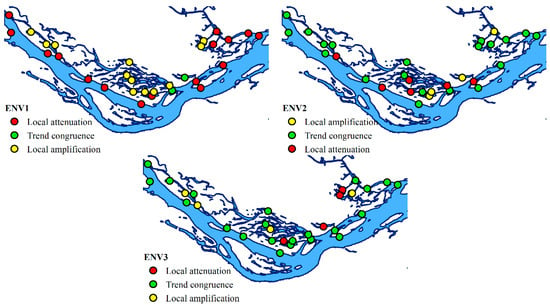
Figure 1

Journal Menu
► ▼ Journal Menu-
- Fishes Home
- Aims & Scope
- Editorial Board
- Reviewer Board
- Topical Advisory Panel
- Instructions for Authors
- Special Issues
- Topics
- Sections & Collections
- Article Processing Charge
- Indexing & Archiving
- Editor’s Choice Articles
- Most Cited & Viewed
- Journal Statistics
- Journal History
- Journal Awards
- Society Collaborations
- Editorial Office
Journal Browser
► ▼ Journal BrowserHighly Accessed Articles
Latest Books
E-Mail Alert
News
Topics
Topic in
Animals, Aquaculture Journal, Biology, Fishes, Hydrobiology
The Importance of Fish Phenotype in Aquaculture, Fisheries and Conservation
Topic Editors: Zonghang Zhang, Xiumei ZhangDeadline: 31 August 2025
Topic in
Animals, Fishes, Veterinary Sciences
Application of the 3Rs to Promote the Welfare of Animals Used in Scientific Research and Testing
Topic Editors: Johnny Roughan, Laura CalvilloDeadline: 20 September 2025
Topic in
Biology, Data, Diversity, Fishes, Animals, Conservation, Hydrobiology
Intersection Between Macroecology and Data Science
Topic Editors: Paulo Branco, Gonçalo DuarteDeadline: 30 November 2025
Topic in
Animals, Antioxidants, Fishes, Biology
Immunology and Disease Prevention and Control in Aquatic Animals
Topic Editors: Hongliang Zuo, Jiejie Sun, Linwei YangDeadline: 31 August 2026

Conferences
Special Issues
Special Issue in
Fishes
Endocrine Disruption in Aquatic Organisms
Guest Editors: Azadeh Hatef, Sayyed Mohammad Hadi AlaviDeadline: 19 July 2025
Special Issue in
Fishes
Impacts of Dietary Supplements on Fish Growth and Health
Guest Editor: Gisele Cristina FaveroDeadline: 25 July 2025
Special Issue in
Fishes
Advances in Aquaculture Feed Additives
Guest Editors: Adolfo Jatobá, Delano Dias SchlederDeadline: 25 July 2025
Special Issue in
Fishes
Fish Processing and Preservation Technologies
Guest Editors: Tao Huang, Chenyang Lu, Zizi HuDeadline: 26 July 2025





